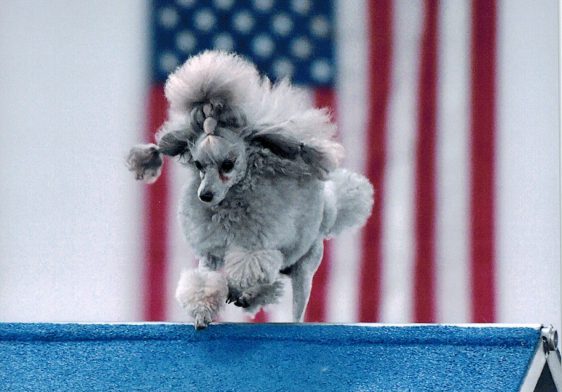
We get to play with Toys!
The Poodle breed in the United States is divided in to three varieties: Standard, Miniature, and Toy. Other countries have a 4th size: Moyen or Klein. Standard poodles were initially analyzed in 2015 with the release of their paper, which was the impetus (in part) for the formation of BetterBred. You can read more about our history on our about us page. Soon thereafter Miniature Poodles were analyzed. However, the third variety, Toys, have finally had their breed report completed! All three varieties were generously funded by the Poodle Club of America Foundation. What did UC Davis Veterinary Genetics Laboratory and esteemed canine researcher Dr. Niels Pedersen discover? Link to the FULL report here.
Inbreeding – how closely related are the parents of the typical Toy Poodle
From the report
Although standard genetic assessment values indicate that Toy Poodles are being randomly bred, the IR values suggest that one-fourth of Toy Poodles have IR values ranging from 0.102 to 0.366. Higher scoring dogs in this population are responsible for the smaller second peak in the IR graph (Fig. 2). The effect of these more inbred dogs is counteracted by an equal population of dogs with IR values below -0.160 to -0.234. This leaves one-half of the population with IR values from -0.060 to +0.102, which represent individuals with reasonably unrelated parents.
Translation? This means a good proportion of the population is keeping their inbreeding down, but 25% have fairly high IR scores (from the paper they have “parents that are quite related, sometimes to the equivalent level of full siblings”) and could benefit from our predictive online software when planning breedings, whether it be an outcross or a linebreeding.
Breed wide diversity
Biodiversity and allelic richness are words we try to discuss regularly at BetterBred. Namely, how many different versions of genes or alleles are there? The breeds with more allelic richness, that are also well distributed, tend to be healthier. What did they find about Toys?
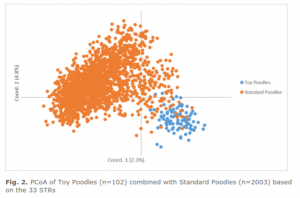
Copyright UC Davis VGL Standard poodles and Toy poodles, notice some overlap between the populations. While separate they share some genetics.
From UC Davis
The average number of alleles/loci (Na) for the Toy Poodles was 8.42, which is higher than many other pure breeds, but not as high as for the parent breed (Standard Poodle Na=8.91). The average number of alleles/locus (Ne) that contributed most to heterozygosity was 4.09, again higher than many pure breeds that have been studied to this point, and even higher than for Standard Poodle (Ne =3.49).
What does this mean? This is happy happy news! In JUST this sample of 100 toys, there is a LOT of diversity to go around, AND it is well distributed. This means if a family encounters an issue, they have lots of options to breed to. Since the inbreeding part of the report indicates that a quarter of the population has high inbreeding scores, this part of the population may want to verify their outcross is really an outcross or that their linebreeding is not too tight. Fortunately there are lots of great options to investigate!
Diversity compared to the Village Dogs
Dr. Pedersen’s hallmark comparison is to a population of village dogs that has a great amount of genetic diversity. They analyze the results per breed to estimate the diversity remaining in each breeding population.
From his report
An estimate of the amount of diversity in dogdom that still exists in Toy Poodles can be made by comparing the blackened area under the two curves with the area of the blue curve. This is around 60%, which is among the highest amount of retained diversity that we have observed and comparable to Miniature Poodles.
Toy Poodles have a lot of diversity to work with!
DLA – a Look at the Immune system
Wowee “We have identified 32 distinct DLA Class I and 20 distinct DLA Class II haplotypes in 102 Toy Poodles tested to date“. This number of DLA types is fantastic for a breed (er variety), and is another indication that they have a lot of genetic diversity within the Toy Poodle population
A very interesting note from the report:
The large number of DLA class I and II haplotypes indicate that many different founders have been involved in the breed’s evolution. As expected, the most DLA class I haplotypes are shared with Miniature and Standard Poodles, but the third most class I haplotype sharing is with the Havanese. Class II haplotype sharing is also common with other small breeds such as the Biewer-type terriers, Yorkshire terrier, Bulldog and the larger Flat Coated Retriever (Table 5).
Since Maltese have yet to be run at UC Davis, it is a reasonable thought that perhaps they also share DLA with Toys, which supports the breed history that Maltese and a “Cuban dog” contributed to its development.
The most common DLA types represented in this variety of Poodle are class I DLA 1018 and class II DLA 2003 haplotypes. These DLA represent a large portion of the sampled DLA, 30 and 44% respectively. From the report “A founder or founder line with the 1018/1023 haplotypes has obviously played an important role in maintaining predominant phenotypes of the Miniature and Toy Poodle breeds and has been highly conserved.”
Conclusion
From Dr. Pedersen’s report:
Although breed-wide standard genetic assessments indicate that the breed is very heterogeneous, internal relatedness (IR) scores indicate that there is still a proportion of individual Toy Poodles that are offspring of parents that are quite related, sometimes to the equivalent level of full siblings. It is important to identify such individuals or bloodlines prior to breeding to find mates that will produce puppies that have much lower IR scores. This should not be a great problem as the breed has great genetic diversity from which to select the best mates.
Well we don’t have much to add! The Toy Poodle population has a lot to work with and should they find they need to outcross, they will easily find that option! They may want to try to breed for heterozygous DLA types to increase the prevalence of the lessor represented DLA, but all in all they can focus on maintaining the diversity they have and breeding for low average litter IRs. Congratulations Toy Poodle Variety!
Have a Poodle? Want to know if your linebreeding is too close or if your outcross is really an outcross?
Come hear Rebekah Zurbrugg from BetterBred talk about the genetic challenges and strengths in all three varieties of poodles! Discuss concepts regarding conservation of genetic diversity and strategies for maintaining or redistribution of genetic diversity at this year’s United Poodle Association‘s meet & greet June 15th at 5:30 pm.
Who will be our next breed to finish? Check back soon!
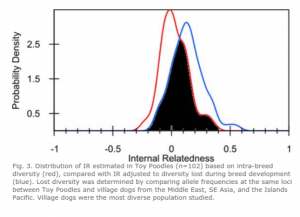
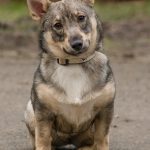 Previous Post
Previous Post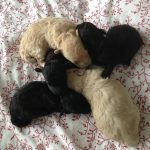 Next Post
Next Post


